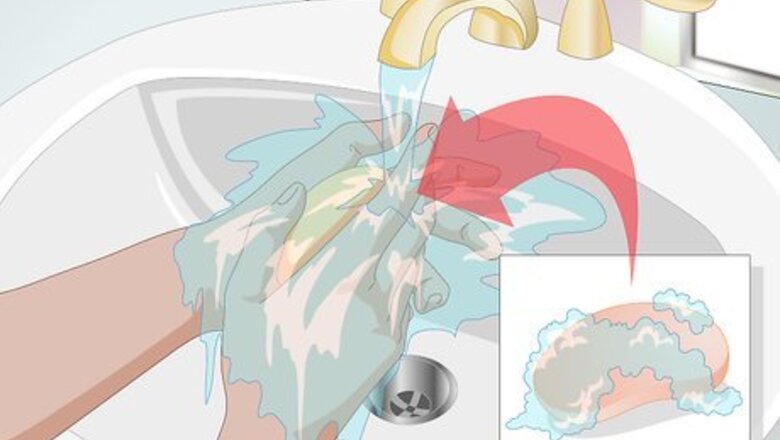
views
Making Playtime Safe
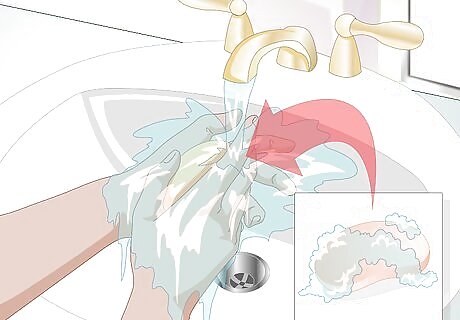
Wash your hands. The first thing you should do before anything else is to wash your hands. Washing your hands will make sure that you don’t introduce anything – bacteria or chemicals – to the snail or to its environment. Use an antibacterial soap. Use warm water. Make sure all soap is thoroughly washed off your hands.
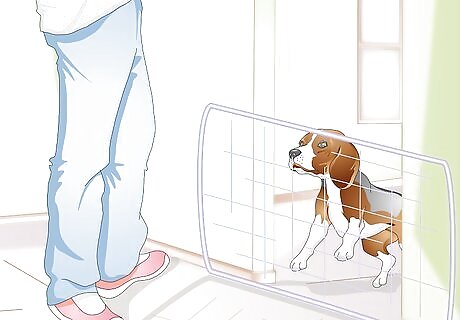
Secure your play area. Before you play with your snail, you need to make sure the room you’re in is secure and snail-ready. By having a room that is secure, you’ll safeguard your snail's life and make playtime a happy time for both of you. Remove any other pets (specifically dogs or cats) from the room. Dogs or cats might see the snail as something to toy with or even eat. Inform any other people what you’ll be doing, so they don’t disturb you. Turn off any loud music or the TV. This is important for the snail and so you can concentrate and won’t be distracted as you’re playing.
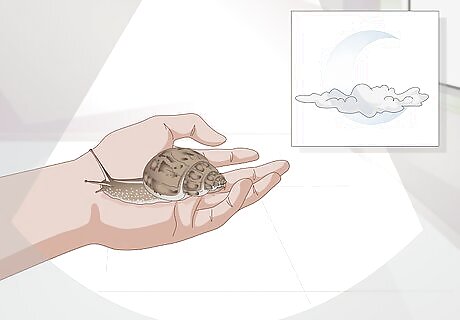
Play with your snail at night. Night time is the best time to play with your snail. This is because most snails are active at night and sleep during the day. If you try to play with your snail during the day, it might not do very much and may just withdraw into the shell. The best time for you and your snail is probably between 6PM and 8PM, depending on your schedule and region.
Picking Up Your Snail
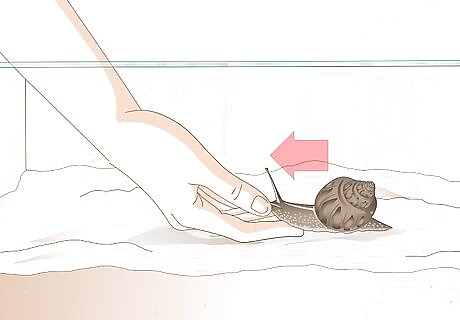
Let the snail crawl onto your hand by itself. The best way to pick your snail up is to let it crawl onto your hand on its own accord. This is by far the safest way for the snail to be carried. Picking a snail up by its shell or body may damage the shell or hurt the snail. Place your hand flat against the bottom of the snail’s cage near the snail. Move your hand very slowly in the general direction of the snail. Let the snail crawl onto your hand.

Lift your hand, slowly. Once the snail has crawled onto your hand, you can slowly lift your hand out of its enclosure. Make sure to lift your hand slowly, as you don’t want to scare the snail or potentially drop it. After you’ve lifted your hand out of the tank, move it slowly toward the surface of a table. Place your hand flat against the surface of the table and allow your snail to move around. Avoid shaking the table or moving your hand suddenly.
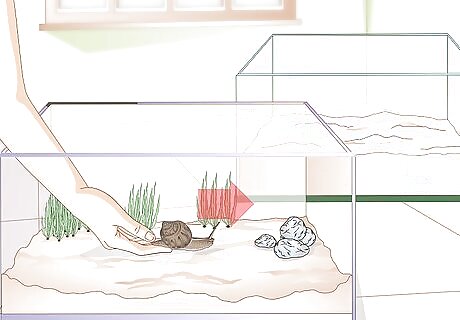
Lower the snail to a new surface. After you’ve got the snail on your hand and have moved it out of the enclosure or somewhere else in the enclosure, lower your hand down and allow the snail to hop off your hand. This is important, as you’ll want to give your snail the freedom to move as it pleases and to explore new areas. Lower your hand slowly. You can lower your hand to a new place in the enclosure. This is probably the best and safest bet. Consider creating a “playground” tank with new rocks, obstacles, and even snail treats (lettuce, cucumbers, and apples). Avoid lowering the snail onto the floor. If you do so, there is a chance you or someone else could step on it.
Interacting with your Snail
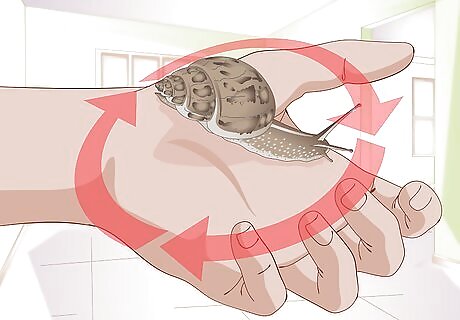
Let it move around. After you’ve gotten yourself ready to play with your snail, you should give it the opportunity to move around. Ultimately, your snail will have the best time if it is moving around on its own accord. Let the snail crawl around your hand. Let the snail crawl around its playground. If you litter food around the snail’s new playground, chances are it will move around to investigate the food and other new additions. Avoid trying to move the snail if it is already moving. You may hurt it. In addition, you may scare your snail, which will make it much more likely that the snail will hide from you next time you go to play with it.
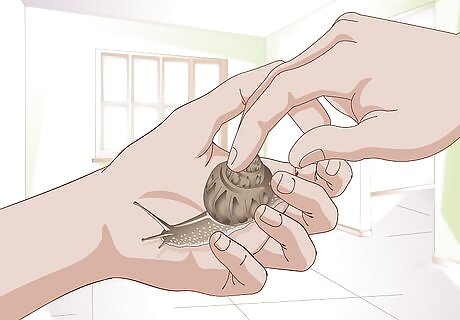
Stroke its shell. If your snail seems to be in a friendly mood, it will be okay to stroke its shell a little bit. Stroking or touching the shell is a great way to interact with your snail and to “play” with it. Stroke or touch the shell lightly. Stroke or touch the shell with the grain, rather than against it.
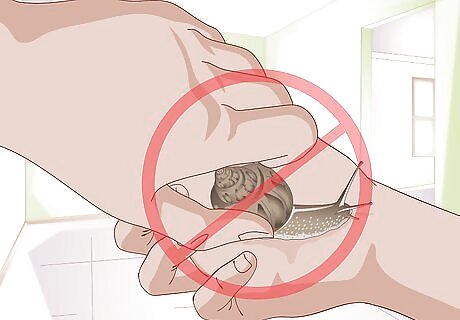
Play gently. You need to be gentle whenever you play with or handle your snail. As living creatures, they are delicate and can be hurt relatively easily. Make sure to: Never apply any pressure on to the snail’s shell. Always move very slowly when handling your snail. Be conscious of the fragility of the snail.
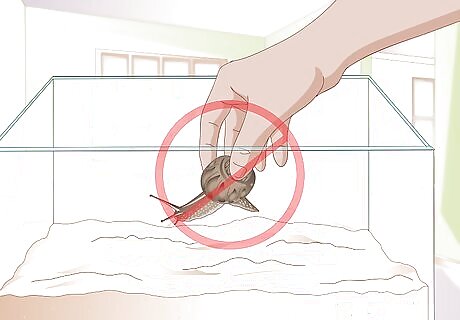
Pick the snail up as little as possible. While you should avoid picking the snail up, there are several things you should do and not do if you do decide to pick up your snail. This is important, since if you do something incorrectly, you may hurt your snail. Do not try to pick up your pet using something sharp. Do not pick up your snail by its shell. The only time this may be appropriate is if your snail is completely withdrawn into its shell and you need to move it. When you do move your snail this way, make sure to be gentle and to avoid applying any pressure to the shell.
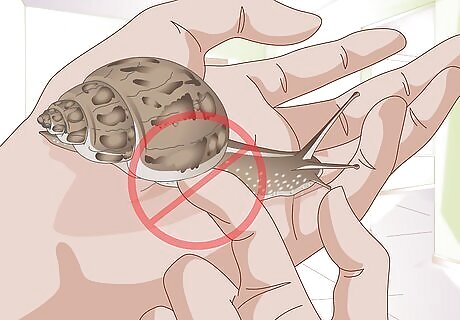
Avoid touching the area around the opening of the shell. When handling your snail, you should make sure to always avoid touching the area around the opening of the shell. This is because a snail’s shell grows at its opening. This makes the area around the opening much more delicate and sensitive. Always grip the shell with two fingers from the top and rear of the shell.
Taking Care of Business after Playtime
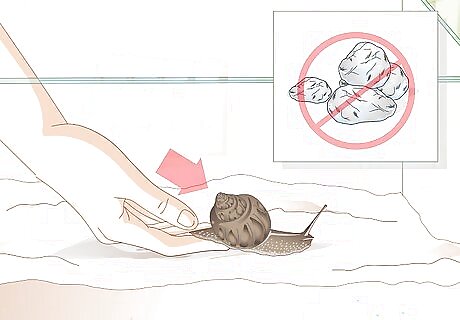
Return the snail to its tank in a safe manner, if you’ve removed it. After playing with your snail, make sure to return it safely back to its tank. Returning it to its tank safely is extremely important as you want to make sure not to harm your snail. In addition, if you are too hurried with your snail, the experience won’t be a positive one and your snail may hide in its shell next time you go to play with it. As with removing your snail from the tank, do so slowly and gently. Make sure you position your snail up right and in a safe location. Avoid placing the snail on a limb, rock, or in any other precarious position in the tank.

Wash your hands. After you’ve handled your snail, you need to make sure to thoroughly wash your hands immediately. This is important as snails carry some diseases and infectious agents that are potentially dangerous to us and the people around us. Use warm water. Use an antibacterial soap. Use plenty of water and wash in between your fingers.
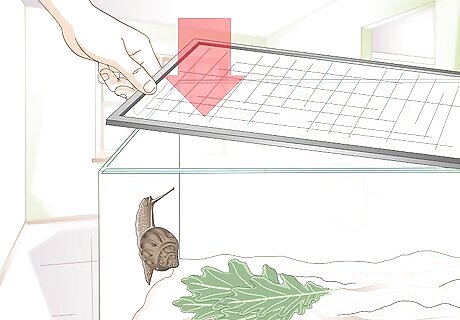
Secure your snail’s tank. After you’ve returned the snail to its tank safely, you need to make sure the top or lid to the tank is completely secured. This is important, since your snail may leave its safe enclosure and become lost if you don’t secure the top of the tank. Place the top on your tank, if there is one. Make sure that the lid is completely on and there are no holes or gaps in it. Secure the clips or other fasteners from the tank to the lid.


















Comments
0 comment